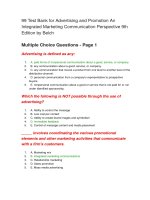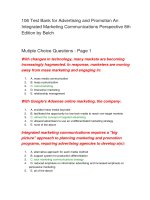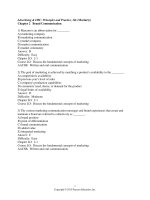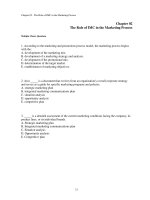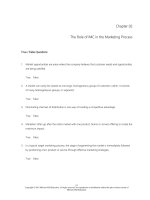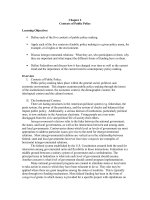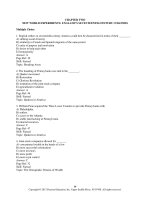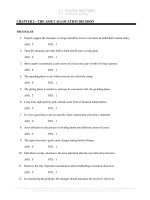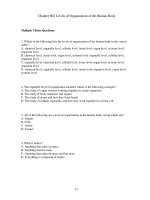Advertising and promotion an integrated marketing communications perspective 10th edition belch test bank
Bạn đang xem bản rút gọn của tài liệu. Xem và tải ngay bản đầy đủ của tài liệu tại đây (552.76 KB, 125 trang )
Chapter 02
The Role of IMC in the Marketing Process
True / False Questions
1.
Market opportunities are areas where the company believes that customer needs and opportunities
are being satisfied.
True
2.
False
A market can rarely be viewed as one large, homogeneous group of customers; rather, it consists
of many heterogeneous groups, or segments.
True
3.
Dominating channels of distribution is one way of creating a competitive advantage.
True
4.
False
False
Marketers often go after the entire market with one product, brand, or service offering to create the
maximum impact.
True
5.
False
In a typical target marketing process, the stage of segmenting the market is immediately followed
by positioning one's product or service through effective marketing strategies.
True
False
2-1
Copyright © 2015 McGraw-Hill Education. All rights reserved. No reproduction or distribution without the prior written consent of
McGraw-Hill Education.
6.
Target market identification isolates consumers with similar lifestyles, needs, and the like, and
increases the knowledge of their specific requirements.
True
7.
The more marketers segment the market, the less precise is their understanding of it.
True
8.
False
False
In the geographic segmentation approach, markets are divided into units based on consumers'
occupations and lifestyles.
True
9.
False
When a market is segmented based on how aware and informed the consumers are, the variable
used to choose a marketing approach is product knowledge.
True
False
10. In the psychographic approach to segmentation, determination of lifestyles is usually based on an
analysis of the activities, interests, and opinions (AIOs) of consumers.
True
False
11. Segmenting the market based on consumers' product or brand usage and the degree of use is an
example of behavioristic segmentation.
True
False
12. Differentiated marketing is used when the firm selects one segment and attempts to capture a
large share of this market.
True
False
2-2
Copyright © 2015 McGraw-Hill Education. All rights reserved. No reproduction or distribution without the prior written consent of
McGraw-Hill Education.
13. The consumer approach positions a product by comparing it and the benefit it offers against those
offered by competitors.
True
False
14. Premium brands positioned at the high end of the market usually use the price/quality approach to
positioning.
True
False
15. While positioning by product class, marketers only position against brands, and not against other
product categories.
True
False
16. Repositioning of a product usually occurs because of declining or stagnant sales.
True
False
17. Strong symbolic features and social and psychological meaning may be more important than
functional utility for many products.
True
False
18. Brand equity refers to the tangible assets earned through a product's functional purpose.
True
False
19. A marketer with an integrated marketing communications (IMC) perspective is likely to link high
relative ad expenditures with premium prices, and low relative ad expenditures with low prices.
True
False
20. Trade advertising focuses on sales promotion efforts directed toward the ultimate consumer.
True
False
2-3
Copyright © 2015 McGraw-Hill Education. All rights reserved. No reproduction or distribution without the prior written consent of
McGraw-Hill Education.
Multiple Choice Questions
21. According to the marketing and promotions process model, the marketing process begins with
the:
A. development of the brand equity.
B. development of a marketing strategy.
C. development of the promotional mix.
D. determination of the promotional budget.
E. establishment of a nano-campaign marketing strategy.
22. According to the marketing and promotions process model, in which of the following stages does
the company decide the product or service areas and particular markets where it wants to
compete?
A. Development of a marketing strategy and analysis
B. Development of the target marketing process
C. Allocation of advertising budget
D. Development of the marketing planning program
E. Creation of a positioning strategy
23. _____ is a detailed assessment of the current marketing conditions facing the company, its product
lines, or its individual brands.
A. Matrix analysis
B. Micro analysis
C. Situation analysis
D. Opportunity analysis
E. Competitive analysis
2-4
Copyright © 2015 McGraw-Hill Education. All rights reserved. No reproduction or distribution without the prior written consent of
McGraw-Hill Education.
24. Which of the following is best defined as areas where there are favorable demand trends, customer
needs and wants are not being satisfied, and where a company thinks it can compete effectively?
A. Market opportunities
B. Market segmentations
C. Marketing channels
D. Marketing-stubs
E. Market economics
25. A situational analysis:
A. does not include an assessment of a company's product lines.
B. usually starts with a positioning strategy.
C. does not include an assessment of the conditions facing the company.
D. typically involves creating branding strategies.
E. includes an assessment of its individual brands.
26. During a routine market study conducted by CL Foods, it was noted that Chinese and Indian food
products were in high demand in American society. In order to take advantage of such a demand,
CL Foods manufactured and sold these food items locally. In this scenario, the company is taking
advantage of a _____.
A. market opportunity
B. market aggregation
C. market assimilation
D. marketing buzz
E. market threat
2-5
Copyright © 2015 McGraw-Hill Education. All rights reserved. No reproduction or distribution without the prior written consent of
McGraw-Hill Education.
27. FunZone Inc. identified and developed a SmartCard that can be used at fair grounds to make the
ticketing process easier. The company found that the existing system was complicated and highly
time-consuming. The SmartCard was easy to operate and each swipe would deduct the cost of a
ride automatically. According to the given scenario, FunZone has recognized a:
A. market opportunity.
B. marketing buzz.
C. marketing engagement.
D. marketing channel.
E. market threat.
28. There are several medicines that relieve allergy-related symptoms but only Sensitine comes in a
quick dissolving form that can be easily swallowed without water. The manufacturer of Sensitine
hopes the fact that it dissolves and enters the system quicker than other brands will create a:
A. market aggregation.
B. marketing assimilation.
C. competitive advantage.
D. cross-merchandising strategy.
E. market dis-intermediation.
29. Offering quality products that command a premium price, providing superior customer service,
having the lowest production costs and lower prices, or dominating channels of distribution are
ways of:
A. achieving competitive advantage.
B. practicing cross-merchandising strategy.
C. creating market space.
D. practicing bait-and-switch marketing.
E. establishing a marketing-stub.
2-6
Copyright © 2015 McGraw-Hill Education. All rights reserved. No reproduction or distribution without the prior written consent of
McGraw-Hill Education.
30. _____ is defined as something unique or special a firm possesses or does that gives it an edge over
other firms in a similar industry.
A. Competitor indexing
B. Switch marketing
C. Competitive advantage
D. Marketing-stub
E. Bait marketing
31. John & Bauer Inc., manufacturers of health drugs, are the manufacturers of a painkiller called JB
Revive. The painkiller is unique as it contains calcium, and it is quite unlike any other pain killer in
the market. The addition of calcium led to an increase in sales of the medicine as well. In this
scenario, the addition of calcium gives the company a:
A. market engagement.
B. cross-merchandising opportunity.
C. competitive advantage.
D. marketing assimilation.
E. competitive index.
32. The first step in the target marketing process is to:
A. develop positioning strategies.
B. request government approval.
C. determine whether to use a market segmentation strategy or a mass marketing strategy.
D. identify markets with unfulfilled needs.
E. develop new products.
2-7
Copyright © 2015 McGraw-Hill Education. All rights reserved. No reproduction or distribution without the prior written consent of
McGraw-Hill Education.
33. The market segmentation process:
A. divides a market into distinct groups that have heterogeneous needs.
B. divides a market into distinct groups that will respond similarly to marketing actions.
C. offers one version of the product to all markets.
D. creates products for several markets that have independent needs.
E. positions products in the minds of prospects and customers.
34. Directing a company's efforts toward one or more groups of customers who share common needs
is known as:
A. cross-merchandising.
B. competitor indexing.
C. mass customization.
D. market segmentation.
E. cross-branding.
35. Dividing the market into units such as nation, states, town, counties, or even neighborhoods is
known as:
A. demographic segmentation.
B. psychographic segmentation.
C. quantified aggregation.
D. lifestyle aggregation.
E. geographic segmentation.
2-8
Copyright © 2015 McGraw-Hill Education. All rights reserved. No reproduction or distribution without the prior written consent of
McGraw-Hill Education.
36. Which of the following is a geographic variable for segmentation of the market?
A. Family size
B. Occasions
C. Counties
D. Age
E. Gender
37. Which of the following is a geographic segmentation variable?
A. Income
B. Neighborhood
C. Sex
D. Education
E. Involvement
38. Delish Inc., a food manufacturer, introduced an instant soup specially designed for and advertised
in the colder regions of Asia and Europe. This is an example of:
A. demographic segmentation.
B. psychographic segmentation.
C. sociocultural segmentation.
D. geographic segmentation.
E. undifferentiated marketing.
2-9
Copyright © 2015 McGraw-Hill Education. All rights reserved. No reproduction or distribution without the prior written consent of
McGraw-Hill Education.
39. Brown's Frozen BBQ Sandwiches are made with goat meat drenched in a sweet onion sauce. These
sandwiches would not be popular in Texas, where people prefer beef, or in Miami where a
mustard-based sauce is preferred. Which of the following segmentation approaches would be best
for the company?
A. Demographic
B. Socioeconomic
C. Personality
D. Geographic
E. Behavioristic
40. Brown's Foods determined that Southerners preferred milder mustard than those in the Northeast.
This led the company to develop a new "Southern Style Mustard." This strategy best exemplifies:
A. geographic segmentation.
B. lifestyle segmentation.
C. socioeconomic segmentation.
D. demographic segmentation.
E. usage segmentation.
41. Which of the following is a primary variable of demographic segmentation?
A. Lifestyle
B. Personality
C. Occupation
D. Education
E. Social class
2-10
Copyright © 2015 McGraw-Hill Education. All rights reserved. No reproduction or distribution without the prior written consent of
McGraw-Hill Education.
42. Division of the market based on age, sex, family size, income, and other measurable characteristics
is known as:
A. demographic segmentation.
B. psychographic segmentation.
C. socioeconomic segmentation.
D. geographic segmentation.
E. undifferentiated segmentation.
43. Jim's Inc., a travel agency in Texas, offers trips that are designed specifically for couples. In this
scenario, the company is using _____ segmentation.
A. geographic
B. demographic
C. lifestyle
D. behavioristic
E. personality
44. Venus Finance aired a series of ads that targeted people born after 1980, also known as Generation
Y. In this scenario, the company is using a _____ segmentation strategy.
A. geographic
B. demographic
C. socioeconomic
D. behavioristic
E. personality
2-11
Copyright © 2015 McGraw-Hill Education. All rights reserved. No reproduction or distribution without the prior written consent of
McGraw-Hill Education.
45. Which of the following is a variable of the demographic segmentation strategy?
A. Personality
B. Marital status
C. Values
D. Lifestyle
E. Occupation
46. Enliven, a sports drink manufacturer, has identified its preferred target market as men between the
ages of 18 to 22 who are currently in high school or college and active in sports. Which of the
following types of segmentation is Enliven using in this scenario?
A. Benefit and demographic
B. Psychographic and geographic
C. Demographic and socioeconomic
D. Geographic and psychographic
E. Socioeconomic and psychographic
47. Dividing the market on the basis of personality and/or lifestyles is referred to as _____.
A. geographic segmentation
B. demographic segmentation
C. psychographic segmentation
D. socio economic segmentation
E. behavioral segmentation
2-12
Copyright © 2015 McGraw-Hill Education. All rights reserved. No reproduction or distribution without the prior written consent of
McGraw-Hill Education.
48. _____ divides a market on the basis of lifecycles.
A. Geographic segmentation
B. Psychographic segmentation
C. Benefit segmentation
D. Demographic segmentation
E. Socioeconomic segmentation
49. Merry Inc. is a non-profit organization that employs a large number of underprivileged people. It
sells art and handicrafts made by these individuals at reasonable prices. Merry's target market
consists of people who believe in helping others. It uses _____ segmentation.
A. demographic
B. geographic
C. psychographic
D. benefit
E. socio economic
50. With respect to psychographic segmentation of markets, AIO stands for:
A. activities, innovation, and opinions.
B. activities, interests, and opportunities.
C. activities, innovations, and opportunities.
D. activities, interests, and opinions.
E. actions, interests, and opinions.
2-13
Copyright © 2015 McGraw-Hill Education. All rights reserved. No reproduction or distribution without the prior written consent of
McGraw-Hill Education.
51. Which of the following is a primary variable used in psychographic segmentation?
A. Income
B. Lifestyles
C. Education
D. Marital status
E. Age
52. Pluto Inc., a car manufacturer, makes high-end, expensive sports cars. The company targets people
who live life on the fast lane and are generally considered to have flashy personalities. In this
scenario, Pluto is using _____ segmentation.
A. psychographic
B. benefit
C. socioeconomic
D. undifferentiated
E. demographic
53. Which of the following is a primary variable defined in psychographic segmentation?
A. Lifecycles
B. Income
C. Education
D. Life stage
E. Gender
2-14
Copyright © 2015 McGraw-Hill Education. All rights reserved. No reproduction or distribution without the prior written consent of
McGraw-Hill Education.
54. _____ segmentation divides consumers into groups according to their usage, loyalties, or buying
responses to a product.
A. Benefit
B. Geographic
C. Demographic
D. Behavioristic
E. Psychographic
55. A company that divides its target markets based on their perceived level of loyalty is using:
A. benefit segmentation.
B. geographic segmentation.
C. socioeconomic segmentation.
D. behavioristic segmentation.
E. outlet segmentation.
56. Which of the following types of segmentation is employed when consumers are grouped according
to their usage and buying responses to a product or service?
A. Behavioristic
B. Demographic
C. Benefit
D. Socioeconomic
E. Psychographic
2-15
Copyright © 2015 McGraw-Hill Education. All rights reserved. No reproduction or distribution without the prior written consent of
McGraw-Hill Education.
57. Degree of usage as a basis of segmentation is best reflected by:
A. the VALS principle.
B. the iceberg principle.
C. the mirror image rule.
D. the rule of equity.
E. the 80-20 rule.
58. _____ segmentation is most closely related to the 80-20 rule, which states that 80 percent of a
company's business comes from 20 percent of its customers.
A. Geographic
B. Behavioristic
C. Demographic
D. Psychographic
E. Benefit
59. The 80-20 rule states that:
A. around 80 percent of the firm's sales comes from 20 percent of the customers.
B. only 80 percent of a market can be segmented.
C. market segmentation works well only 80 percent of the time, unlike market assimilation that
works 20 percent of the time.
D. only about 80 percent of the people remember the firm's positioning of a product while the
remaining 20 percent create their own positioning for a particular product.
E. about 80 percent of corporations do not understand the actual meaning of the term "market
segmentation."
2-16
Copyright © 2015 McGraw-Hill Education. All rights reserved. No reproduction or distribution without the prior written consent of
McGraw-Hill Education.
60. Dental Care, a dental hygiene products manufacturer, has come up with three types of toothpastes
for different segments—whitening toothpaste for individuals who buy for aesthetic reasons,
strawberry flavored toothpaste for those concerned with the taste, and germ-control toothpaste for
those looking to protect their teeth all day long. On what basis has it segmented the market?
A. Demographic
B. Geographic
C. Socioeconomic
D. Benefit
E. Sociocultural
61. _____ segmentation is the grouping of customers on the basis of attributes sought in a product.
A. Benefit
B. Geographic
C. Socioeconomic
D. Demographic
E. Lifestyle
62. Momentum, a brand of sports cars, launched an advertising campaign with a tagline that states
"Our cars outperform most cars on the road even before you step on the accelerator." In this
scenario, the company is using _____ segmentation.
A. benefit
B. demographic
C. geographic
D. psychographic
E. socioeconomic
2-17
Copyright © 2015 McGraw-Hill Education. All rights reserved. No reproduction or distribution without the prior written consent of
McGraw-Hill Education.
63. WristTactical, a watch manufacturer, specializes in manufacturing tactical watches for Navy divers.
The company launched an ad campaign that stressed the water resistant and endurance
characteristics of its watches. In this scenario, WristTactical is making use of _____ segmentation.
A. benefit
B. demographic
C. geographic
D. behavioristic
E. socioeconomic
64. The fact that some consumers want flavored bottled water and others want it with added minerals
provides an opportunity for _____ segmentation.
A. socioeconomic
B. benefit
C. geographic
D. psychographic
E. demographic
65. Which of the following is a primary variable considered in benefit segmentation?
A. Attributes sought
B. Income
C. Lifestyle
D. Birth era
E. Marital status
2-18
Copyright © 2015 McGraw-Hill Education. All rights reserved. No reproduction or distribution without the prior written consent of
McGraw-Hill Education.
66. According to the market coverage alternatives, _____ involves ignoring segment differences and
offering just one product or service for the entire market.
A. bait-and-Switch marketing
B. concentrated marketing
C. micro-marketing
D. neuromarketing
E. undifferentiated marketing
67. Frosty Inc., a beverage manufacturer, only had one product in its line and was targeting all types of
customers. With respect to the market coverage alternatives, which of the following would best suit
the company?
A. Concentrated marketing
B. Undifferentiated marketing
C. Bait-and-switch marketing
D. Niche marketing
E. Psychographic marketing
68. Which of the following is true of undifferentiated marketing?
A. It involves selecting one segment and attempting to capture a large market share.
B. It involves offering just one product or service to the entire market.
C. It involves creating a niche for a special product line.
D. It involves customizing products for various target segments.
E. It involves developing and offering a product for a specific market segment.
2-19
Copyright © 2015 McGraw-Hill Education. All rights reserved. No reproduction or distribution without the prior written consent of
McGraw-Hill Education.
69. With respect to the market coverage alternatives, _____ involves developing separate marketing
strategies for a number of segments.
A. differentiated marketing
B. undifferentiated marketing
C. concentrated marketing
D. buzz marketing
E. B to B marketing
70. Mars Inc., a car manufacturer, offers cheap coupes, medium-priced sedans, as well as expensive
sports cars. The company identifies and develops various products for several segments. This
scenario is an illustration of:
A. concentrated marketing.
B. loyalty marketing.
C. buzz marketing.
D. bait-and-switch marketing.
E. differentiated marketing.
71. Chill, a beverage manufacturer, offers varied versions of its products that include diet, cherry
flavored, vanilla flavored, and caffeine-free versions in addition to its original product. With respect
to market coverage alternatives, the given scenario reflects the company's decision to cater to:
A. a concentrated market.
B. a differentiated market.
C. a buzz market.
D. an undifferentiated market.
E. a mass market.
2-20
Copyright © 2015 McGraw-Hill Education. All rights reserved. No reproduction or distribution without the prior written consent of
McGraw-Hill Education.
72. _____ is used when the firm selects one segment and attempts to capture a large share of the
market.
A. Mass marketing
B. Undifferentiated marketing
C. Concentrated marketing
D. Differentiated marketing
E. Bait-and-switch marketing
73. Concentrated marketing involves focusing marketing efforts on:
A. different countries.
B. one particular segment.
C. mass markets.
D. various segments.
E. different counties.
74. Star Furniture designs and sells bedroom furniture for people who are over six-feet tall, which is a
relatively small target market. Which of the following strategies is the company employing in this
scenario?
A. Differentiated marketing
B. Bait-and-switch marketing
C. Undifferentiated marketing
D. Concentrated marketing
E. Mass marketing
2-21
Copyright © 2015 McGraw-Hill Education. All rights reserved. No reproduction or distribution without the prior written consent of
McGraw-Hill Education.
75. Pluto Inc., a high-end car manufacturer, makes only 12 cars per year. The company caters only to
the "super-rich" and manufacturers only on order. In this scenario, Pluto is using a _____ marketing
strategy.
A. differentiated
B. undifferentiated
C. concentrated
D. mass
E. loyalty
76. Which of the following is true of concentrated marketing strategies?
A. They are used to promote multiple products in varied markets.
B. They are used as a precursor to undifferentiated marketing.
C. They usually involve only a single segment.
D. They attempt to catch a minority share in the market.
E. They are synonymous with undifferentiated marketing strategies.
77. Outlander Inc. is a manufacturer of laptop computers. It plans on manufacturing computers that
are targeted to users interested in video games. The computers are optimized for high-definition
gaming and hence are expensive. Which of the following types of marketing strategies has
Outlander adopted?
A. Bait-and-switch marketing
B. Undifferentiated marketing
C. Concentrated marketing
D. Buzz marketing
E. Differentiated marketing
2-22
Copyright © 2015 McGraw-Hill Education. All rights reserved. No reproduction or distribution without the prior written consent of
McGraw-Hill Education.
78. _____ has been defined as "the art and science of fitting the product or service to one or more
segments of the broad market in such a way as to set it meaningfully apart from competition."
A. Branding
B. Proximity mapping
C. Drip marketing
D. Segmentation
E. Positioning
79. Which of the following is true of product positioning?
A. It does not focus on a product's competitors.
B. It is not possible to position a service.
C. It focuses purely on customers.
D. It involves creating a competitive advantage.
E. It is usually synonymous with market integration.
80. A brand's market position refers to its:
A. relative market share.
B. location on store shelves.
C. image in the mind of the customers.
D. distribution intensity.
E. stage in the product life cycle.
81. _____ relates to the image of a product and or brand relative to competing products or brands.
A. Segmentation
B. Positioning
C. Neuromarketing
D. Branding
E. Merchandising
2-23
Copyright © 2015 McGraw-Hill Education. All rights reserved. No reproduction or distribution without the prior written consent of
McGraw-Hill Education.
82. Momentum, a car manufacturer, positions one of its convertible as "the best natural tanning tool
known to man." This scenario would reflect a positioning strategy based on:
A. product attributes and benefits.
B. cultural symbols.
C. product user.
D. price/quality.
E. product class.
83. The tagline on an ad for Baker Grill, a manufacturer of gas grills, reads, "The Ultimate Durable Grill"
Baker Grill is using a positioning strategy based on:
A. product class.
B. product attributes and benefits.
C. price/quality.
D. competitor.
E. cultural symbol.
84. MusC, a whey protein supplement, is positioned as a zero-carb muscle recovery drink. MusC is
using a _____ positioning strategy.
A. product class
B. product attributes and benefits
C. price/quality
D. competitor
E. cultural or national symbol
2-24
Copyright © 2015 McGraw-Hill Education. All rights reserved. No reproduction or distribution without the prior written consent of
McGraw-Hill Education.
85. Flash Parcel Service (FPS) built its advertising campaign around the slogan, "Our business quality
speaks the language of speed." The company positioned its services based on the speed with which
it delivers the service. With respect to the positioning strategies, this positioning strategy of FPS is
based on:
A. cultural symbols.
B. demographics.
C. product class.
D. product attributes.
E. socioeconomics.
86. Appeal Automobiles introduced a new car into the market. The company stressed that the new car
had side door air bags in an attempt to attract new buyers. Its focus on safety illustrates a strategy
of positioning by:
A. cultural or national symbols.
B. demographics.
C. price-value.
D. product attributes and benefits.
E. competitor.
87. Henry's Supermarkets have been very effective in positioning itself as stores that offer superior
products at a discounted rate. With respect to the positioning strategies, its strategy reflects
positioning based on:
A. benefit.
B. applications.
C. use.
D. price/quality.
E. product class.
2-25
Copyright © 2015 McGraw-Hill Education. All rights reserved. No reproduction or distribution without the prior written consent of
McGraw-Hill Education.

